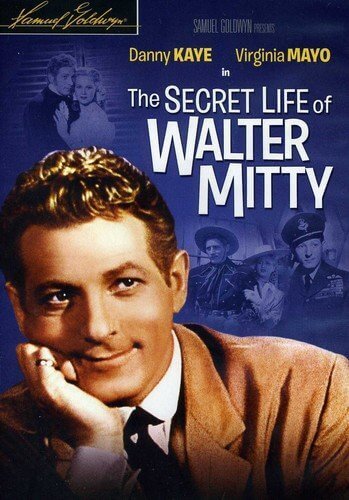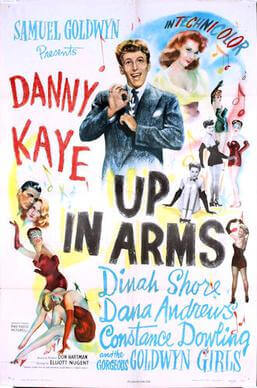Comic Danny Kaye would now be more than 105 years old if he were living. Let’s look back at the career of a man who conquered the stage, film, television, concerts, and USO tours. Danny Kaye was a dancer, singer, pantomime artist and comedian who used physical comedy to his advantage. He was famous for his rapid nonsense songs, usually written by his wife, Sylvia Fine.
Most people today who are classic movie fans remember Kaye from his series of Technicolor musical comedies such as The Court Jester (1956), Hans Christian Andersen (1952), Up in Arms (1944), and A Song is Born (1948) among many others. But, his show business life began many years before those films were made.
Danny Kaye was born David Daniel Kaminsky January 18, 1911 (although he claimed to have been born in 1913) in Brooklyn, New York. His parents were Ukrainian immigrants who settled in New York, along with all the thousands of other immigrants from Italy, Ireland, Poland, and Spain who flocked to the United States at the turn of the 19th century. Kaye was the first child to be born in the USA as his brothers had been born in the old country. Having been born in Brooklyn and having grown up on the tough streets of New York, Kaye learned to fend for himself after his mother died when he was a teenager.
After working at a series of low-skilled jobs such as a soda jerk and office go-fer, he and his best friend Louis went to Florida and set up a singing and guitar act. They starved and returned to New York and worked in the Catskill Mountain resorts in what is called the Borscht Circuit. Kaye honed his comic and singing skills while still a teenager over a period of four seasons.
By 1933, Kaye was ready for a break and he got it with a vaudeville dance act called Three Terpsichoreans. David Daniel Kaminski changed his name to “Danny Kaye” and was billed that way for the first time in show business. The act toured the United States and then went on to Asia for six months.
Now in the height of the Depression in the mid-1930s, the United States was short on jobs for its citizens. Show business was especially hard-hit, and Kaye was not able to find any decent bookings. He was finally booked to work with sensational fan dancer Sally Rand in her burlesque revue.
A Missouri girl born in 1904, Sally Rand worked her way up as a chorus girl at age 13. Working in various shows she also appeared in a few films. In 1934 she caused a sensation at the Chicago World’s Fair by appearing nearly nude with her fan dancing routine. Using either ostrich feathers or balloons, she would hide behind them in hopes of covering all her assets. Unfortunately, she was arrested four times in one day by the police who thought her act was scandalous. The public ate it up and she became a star. It was into this world Kaye worked on the stage with her.
During the 1930s and 1940s there were small movie studios that specialized in musical comedy short films. Kaye made his film debut in one of these shorts called Moon Over Manhattan in 1935. They were very low-budget pictures that served a purpose as “fillers” between the main features. He played occasionally in these shorts until 1938.
There was room for Kaye in a little 1939 production called “Straw Hat Revue” in which his wife Sylvia Fine wrote some special material for Danny. She also served as pianist and lyricist for the show. With a cast of newcomers that included comedienne Imogene Coca, singer Alfred Drake and dancer Jerome Robbins, Kaye managed to steal the show. Writer Bide Dudley of the St. Joseph News Press said, “’The Straw Hat Revue’ isn’t an elaborate affair, but it is clean and hugely satisfying most of the time. It is written, acted and staged with skill and the fact is due largely to the ability of (director) Max Liebman (1902-1981).”
Liebman was mostly responsible for the television careers of Sid Caesar, Ms. Coca, Howard Morris, Carl Reiner, Mary McCarty and Bobby Van on the hit program Your Show of Shows (1949-1954).
La Martinique was a very fancy night club in New York. It drew many show business people who wanted to see the latest acts in the show. Danny Kaye was hired to perform in a show with Sylvia Fine. One night famed Broadway playwright Moss Hart saw their act and was greatly impressed. He was producing a new musical called “Lady in the Dark” (1941) and immediately cast Kaye in the show. Songwriters Kurt Weill and Ira Gershwin wrote a fast-paced song “Tchaikovsky.” In it, Kaye rattled off about 50 Russian composers at breakneck speed and stopped the show every night. Kaye was a sensation. Others in the cast were Broadway veteran Gertrude Lawrence, future film hunk Victor Mature (Demetrius and the Gladiators) and film actor Macdonald Carey.
Kaye was immediately hired for his next show called “Let’s Face It” (1942) in which he played a young man who gets drafted into military service. All his other cast members, including sharp-tongued Eve Arden, I Love Lucy’s best friend Vivian Vance, and MGM musical performer Nanette Fabray, were soon to become prominent film and television stars in their own right.
Kaye made quite a name for himself on Broadway and in soignée cabarets in and about New York. The next step was Hollywood, and who other than movie titan Samuel Goldwyn discovered him for films. Goldwyn was a phenomenon in Hollywood in that he owned his own studio on Santa Monica Boulevard (still there but renamed) and he financed all his films himself.
To understand Kaye’s career at Goldwyn Pictures, we should know a little about Mr. Goldwyn himself. He indeed was a self-made man. Born in Poland in 1879, he made his way to the United States in 1899 and settled in upstate New York. The garment industry was very large in that territory, and Goldwyn (formerly Goldfish) went into the glove business and became very successful. He was in on the beginning of the fledgling movie business by his shear association with his brother-in-law Jesse L. Lasky, director Cecil B. DeMille, and businessman Arthur Friend. The then-young men formed the Jesse L. Lasky Feature Play Company to produce motion pictures for the new industry. They made history by filming the first feature length motion picture in Hollywood called The Squaw Man, as directed by De Mille, in December 1913.
In 1914, Paramount distributors called Lasky to ask him to make 36 films for the company because they did not produce films themselves – only distributed them. Lasky then merged with Adolph Zukor’s Famous Players in June 1916. Zukor also bought out Paramount stock and became president of that company. Goldfish became chairman of the board. After a tiff with Zukor, Goldfish resigned his position in September 1916.
That same year, Goldfish found Broadway producing brothers Edgar and Archibald Selwyn. They merged their names and formed Goldwyn Pictures. Thus, Samuel Goldfish became “Goldwyn” for the first time when he adopted the name as his own.
Another film mogul, Marcus Loew, had gobbled up Louis B. Mayer’s Metro Pictures and then merged with the Goldwyn Company in 1924 to form Metro-Goldwyn-Mayer studios. Although Samuel Goldwyn never produced a picture at MGM, his name has remained in the title until this day.
Goldwyn had already been thinking ahead about forming his own studio and created Samuel Goldwyn Productions in 1923. For the next 40 years, Goldwyn was the biggest and most successful independent producer in Hollywood. He produced such award-winning films as Wuthering Heights with Merle Oberon and Laurence Olivier in 1939, The Little Foxes in 1941 with Bette Davis and Herbert Marshall, Ball of Fire (1941) with Gary Cooper and Barbara Stanwyck, the war-time hit The Best Years of Our Lives with Myrna Loy, Fredric March and Virginia Mayo in 1946, The Bishop’s Wife (1947) with Cary Grant, David Niven and Loretta Young, and Guys and Dolls with Frank Sinatra and Marlon Brando cavorting in wide screen in 1955.
But those were not all the films Goldwyn produced at his compact little studio. He took a liking to Broadway newcomer Danny Kaye, not because he was a nice Jewish boy like Goldwyn himself, but because Kaye was wildly talented and popular with audiences.
Goldwyn signed Kaye in 1944 to star in his wartime musical Up in Arms. Kaye plays a hypochondriac who joins the army. Partnered with young Dinah Shore and Dana Andrews, Kaye cavorted through the Technicolor film and garnered new fans everywhere. The New York Daily Mirror said, “Not since Greta Garbo made her bow has there been anything so terrific as the inimitable Danny, one of the most exhilarating and spontaneous personalities in film history.”
While under contract to Goldwyn for the next several years, Kaye made a variety of hits with some misses. His leading lady in four pictures was the beautiful blond Virginia Mayo, another Goldwyn contractee. Kaye and Mayo made Wonder Man (1945) with dancer Vera-Ellen, The Kid from Brooklyn (1946) with Eve Arden and Vera Ellen, The Secret Life of Walter Mitty (1947) with Ann Rutherford, and A Song Is Born (1948) with band leader Benny Goodman.
Miss Mayo was a staple in Goldwyn films. Just as MGM had luscious Lana Turner, Goldwyn had Mayo. St. Louis-born Mayo (nee: Virginia Clara Jones, 1920-2005) began in acting classes at age six and also took dancing lessons. She began by appearing in the St. Louis Opera Company. As a teen she paired up with her brother-in-law Andy Mayo and took his last name in 1937. Being a seasoned vaudeville performer, she found her way to Broadway and was cast in comic Eddie Cantor’s show “Banjo Eyes” in 1941. With Cantor also being a Goldwyn Productions star, Mr. Goldwyn saw Mayo on stage and signed her to a movie contract. She was made for Technicolor and was a perfect foil for Danny Kaye’s screen antics.
The year 1947 saw Kaye team up with the fabulously popular Andrews Sisters for the recording “Civilization (Bongo, Bongo, Bongo)” which topped the charts as a novelty item. The lyrics were nonsensical, but fun: “Bongo, bongo, bongo, I don’t want to leave the Congo, oh, no, no, no, no. Bingo, bango bongo, I refuse to go!” They recorded several other hit songs through 1950. The Andrews Sisters were the top singing group all through World War II and were famous for their hit songs “Boogie Woogie Bugle Boy” (1941) and “Bei Mir Bist Du Shon” (1938). They brightened several Abbott and Costello comedies and made a lot of money for Universal studios.
After Kaye’s time was up at Goldwyn studios, he made pictures for other studios such as The Inspector General (1949) with Elsa Lanchester at Warner Bros., On the Riviera (1951) with Gene Tierney at 20th Century Fox, White Christmas (1954) with Bing Crosby, Rosemary Clooney and Vera-Ellen at Paramount, Merry Andrew (1958) with Pier Angeli at MGM, and The Man From The Diner’s Club (1963) with Cara Williams and Martha Hyer at Columbia.
As his film roles began to taper off, Kaye turned to television. He launched the very successful Danny Kaye Show, which ran from 1963 to 1967. It won four television Emmy Awards and the prestigious Peabody Award.
He added several television specials to his repertoire including the musical version of Pinocchio with Sandy Duncan. Playing the baddie Captain Hook in the 1975 NBC-TV Anthony Newly-Leslie Bricusse musical version of Peter Pan with Mia Farrow put another feather in his cap. He continued to appear in various roles on television, including comical and dramatic.
Danny Kaye had become enamored of helping children around the world and, as such, he became an Ambassador for UNICEF. He conducted many orchestras in comical performances to raise money for UNICEF programs. Throughout his life he raised money for many charities, but the musicians pension fund was a favorite.
Kaye’s heart gave out in March 1987. His wife, Sylvia Fine, survived him as did his daughter Dena (born 1946). Kaye will always be loved by his millions of fans around the world for his zany antics and wildly entertaining films.








